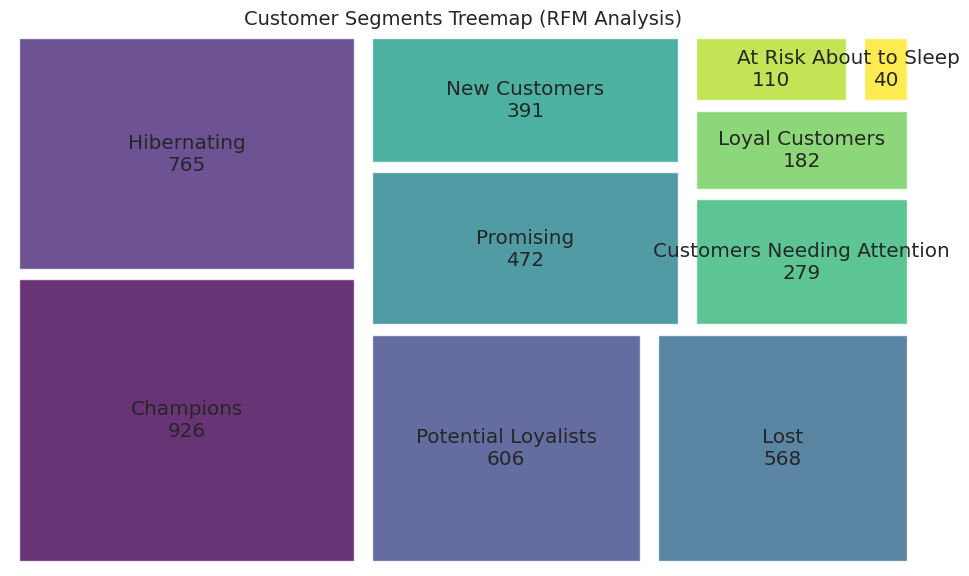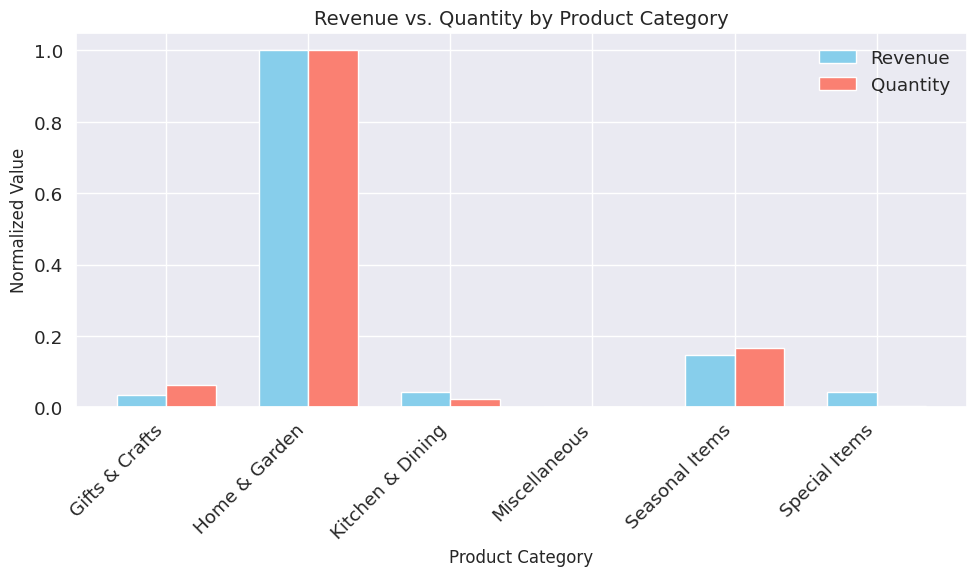Business Recommendations
Customer Segmentation Strategies
Customer Segments

Segment-Specific Strategies:
For High-Value Regular Customers (Cluster 0)
- Develop a dedicated loyalty program with exclusive rewards
- Provide premium and personalized customer service
- Send advance notifications of new products and special offers
For Recent Low-Value Customers (Cluster 1)
- Provide incentives for repeat purchases (e.g., discounts on next order)
- Send personalized product recommendations based on previous purchases
- Encourage order value increase through "spend more, save more" offers
For Inactive High-Value Customers (Cluster 2)
- Implement reactivation campaigns with attractive offers
- Conduct surveys to understand why they stopped purchasing
- Offer exclusive discounts to return
For Low-Value Occasional Customers (Cluster 3)
- Evaluate retention cost versus potential value
- Selectively target with low-cost offers
- Experiment with different strategies to increase customer value
Sales and Marketing Optimization
Sales Distribution by Country

Revenue vs. Quantity by Category

Geographic Expansion:
- Target markets outside the UK with good performance such as Netherlands, EIRE, and Germany
- Develop customized marketing strategies for each market
- Improve shipping and delivery options for international markets
- Consider localized websites and marketing materials for key markets
- Explore partnerships with local retailers in target countries
Product Strategy Optimization:
- Focus on developing and promoting best-performing product categories
- Review products with high return rates to improve quality
- Implement cross-selling strategies based on market basket analysis
- Expand product lines in high-margin categories
- Consider discontinuing or redesigning consistently underperforming products
Pricing Optimization:
- Adjust prices for products with high price elasticity to increase demand
- Maintain higher profit margins for products with low price elasticity
- Develop dynamic pricing strategies based on seasonality and demand
- Implement tiered pricing structures for different customer segments
- Test price points regularly to optimize revenue and profit
Customer Retention Improvement
Churn Prediction Factors

Customer Retention by Cohort

Churn Prevention:
- Use the churn prediction model to identify at-risk customers
- Implement proactive interventions for customers with high churn probability
- Create customized reactivation programs for each customer segment
- Develop an early warning system for declining purchase frequency
- Implement win-back campaigns for recently churned customers
Customer Experience Improvement:
- Streamline the purchasing process and improve user experience
- Develop an easy and clear return policy to reduce return rates
- Regularly collect and implement customer feedback
- Improve product descriptions and images to set accurate expectations
- Enhance post-purchase communication and support
Loyalty and Reward Programs:
- Create a tiered loyalty program with increasing benefits
- Offer rewards for referrals and encourage positive word-of-mouth
- Celebrate important customer milestones (e.g., anniversary of first purchase)
- Implement a points system that rewards both purchase frequency and value
- Provide exclusive access to new products or sales for loyal customers
Operational Improvements
Inventory Management
- Optimize inventory levels based on seasonal forecasts
- Implement an alert system for products that are about to run out
- Review and improve the supply chain for high-demand products
- Use sales forecasting to plan inventory purchases
- Implement just-in-time inventory for appropriate product categories
Product Quality Improvement
- Analyze return reasons and implement improvements for products with high return rates
- Improve product descriptions and images to reduce customer expectation mismatch
- Develop quality control standards for new products
- Regularly review product performance and customer feedback
- Establish quality benchmarks for each product category
Timing and Seasonality Optimization
- Plan promotional campaigns around peak times (Thursday, 12 PM)
- Prepare for the holiday season with increased inventory and staff
- Develop strategies to boost sales during slow periods
- Align email marketing and promotions with optimal days/times
- Create seasonal product bundles to increase average order value
Implementation Roadmap
| Phase | Timeline | Key Activities | Expected Outcomes |
|---|---|---|---|
| Phase 1: Quick Wins | 1-3 months |
|
|
| Phase 2: Retention Focus | 3-6 months |
|
|
| Phase 3: Expansion | 6-12 months |
|
|
| Phase 4: Optimization | 12+ months |
|
|
Expected Business Impact
+15%
Revenue Growth
Through improved customer retention, higher order values, and market expansion
-25%
Customer Churn Reduction
By implementing targeted retention strategies and improving customer experience
+20%
Customer Lifetime Value
Through increased purchase frequency and higher average order values
"By implementing these recommendations, the online retail business can improve its performance, increase customer loyalty, and promote long-term sustainable growth."